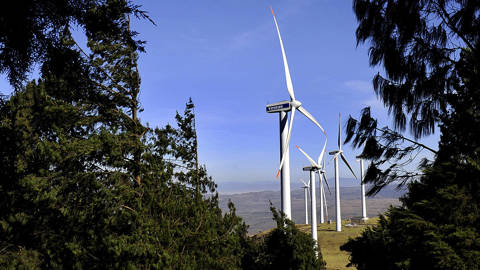Spending on megaprojects already amounts to some $6-9 trillion a year, roughly 8% of global GDP, making them the biggest investment boom in human history, and that number is expected to grow. But unless the explosion in megaprojects is carefully managed, the effort is likely to be counterproductive and unsustainable.
WASHINGTON, DC – We seem to be entering a new age of megaprojects, as countries, in particular those of the G-20, mobilize the private sector to invest heavily in multi-million (if not multi-billion or multi-trillion) dollar infrastructure initiatives, such as pipelines, dams, water and electricity systems, and road networks.
Already, spending on megaprojects amounts to some $6-9 trillion a year, roughly 8% of global GDP, making this the “biggest investment boom in human history.” And geopolitics, the pursuit of economic growth, the quest for new markets, and the search for natural resources is driving even more funding into large-scale infrastructure projects. On the cusp of this potentially unprecedented explosion in such projects, world leaders and lenders appear relatively oblivious to the costly lessons of the past.
To be sure, investments in infrastructure can serve real needs, helping meet an expected surge in the demand for food, water, and energy. But, unless the explosion in megaprojects is carefully redirected and managed, the effort is likely to be counterproductive and unsustainable. Without democratic controls, investors may privatize gains and socialize losses, while locking in carbon-intensive and other environmentally and socially damaging approaches.
To begin with, there is the issue of cost effectiveness. Rather than adopting a “small is beautiful” or a “bigger is better” philosophy, countries must build “appropriate scale” infrastructure suited to its purposes.
Bent Flyvbjerg, a professor at the University of Oxford specialized in program management and planning, studied 70 years of data to conclude that there is an “iron law of megaprojects”: they are almost invariably “over budget, over time, over and over again.” They are also, he adds, subject to the “survival of the unfittest,” with the worst projects getting built, instead of the best.
This risk is augmented by the fact that these megaprojects are driven largely by geopolitics – not careful economics. From 2000 to 2014, as global GDP more than doubled to $75 trillion, the G-7 countries’ share of the world economy dropped from 65% to 45%. As the international arena adjusts to this rebalancing, the United States has begun to worry that its hegemony will be challenged by new players and institutions, such as the China-led Asian Infrastructure Investment Bank. In reaction, the Western-led institutions, such as the World Bank and the Asian Development Bank, are aggressively expanding their infrastructure investment operations, and are openly calling for a paradigm shift.
The G-20, too, is accelerating the launch of megaprojects, in the hope of boosting global growth rates by at least 2% by 2018. The OECD estimates that an additional $70 trillion in infrastructure will be needed by 2030 – an average expenditure of a little more than $4.5 trillion per year. By comparison, it would take an estimated $2-3 trillion per year to meet the Sustainable Development Goals. Clearly, with megaprojects, the potential for waste, corruption, and the buildup of unsustainable public debts is high.
The second issue that must be considered is planetary boundaries. In a March 2015 letter to the G-20, a group of scientists, environmentalists, and opinion leaders warned that ramping up investment in megaprojects risks irreversible and catastrophic damage to the environment. “Each year, we are already consuming about one-and-a-half planets’ worth of resources,” the authors explained. “Infrastructure choices need to be made to alleviate rather than exacerbate this situation.”
Similarly, the Intergovernmental Panel on Climate Change cautions that “infrastructure developments and long-lived products that lock societies into greenhouse-gas-intensive emissions pathways may be difficult or very costly to change.” And, indeed, the G-20 has put in place few social, environmental, or climate-related criteria for the “wish list” of mega-projects that each member country will submit to its summit in Turkey in November.
The third potential problem with megaprojects is their reliance on public-private partnerships. As part of the renewed focus on large-scale investments, the World Bank, the International Monetary Fund, and other multilateral lenders have launched an effort to reengineer development finance by, among other things, creating new asset classes of social and economic infrastructure to attract private investment. “We need to tap into the trillions of dollars held by institutional investors… and direct those assets into projects,” said World Bank Group President Jim Yong Kim.
By using public money to offset risk, the institutions hope to attract long-term institutional investors – including mutual funds, insurance companies, pension funds, and sovereign-wealth funds – who together control an estimated $93 trillion in assets. Their hope is that tapping this huge pool of capital will enable them to scale-up infrastructure and transform development finance in ways that would have been previously unimaginable.
The trouble is that public-private partnerships are required to provide a competitive return on investment. As result, according to researchers at the London School of Economics, they “are not regarded as an appropriate instrument for [information technology] projects, or where social concerns place a constraint on the user charges that might make a project interesting for the private sector.” Private investors seek to sustain the rate of return on their investments through guaranteed revenue streams and by ensuring that laws and regulations (including environmental and social requirements) do not cut into their profits. The risk is that the quest for profit will undermine the public good.
Finally, the rules governing long-term investment do not effectively incorporate long-term environmental and social related risks, as emphasized by trade unions and the United Nations Environment Program. Pooling infrastructure investments in portfolios or turning development sectors into asset classes could privatize gains and socialize losses on a massive scale. This dynamic can increase levels of inequality and undermine democracy, owing to the lack of leverage that governments – much less citizens – may have over institutional investors. In general, trade rules and agreements compound these problems by putting the interests of investors over those of ordinary citizens.
Left unexamined, the push toward megaprojects risks – in the words of the authors of the letter to the G-20 – “doubling down on a dangerous vision.” It is critical that we ensure that any transformation of development finance be crafted in a way that upholds human rights and protects the earth.











WASHINGTON, DC – We seem to be entering a new age of megaprojects, as countries, in particular those of the G-20, mobilize the private sector to invest heavily in multi-million (if not multi-billion or multi-trillion) dollar infrastructure initiatives, such as pipelines, dams, water and electricity systems, and road networks.
Already, spending on megaprojects amounts to some $6-9 trillion a year, roughly 8% of global GDP, making this the “biggest investment boom in human history.” And geopolitics, the pursuit of economic growth, the quest for new markets, and the search for natural resources is driving even more funding into large-scale infrastructure projects. On the cusp of this potentially unprecedented explosion in such projects, world leaders and lenders appear relatively oblivious to the costly lessons of the past.
To be sure, investments in infrastructure can serve real needs, helping meet an expected surge in the demand for food, water, and energy. But, unless the explosion in megaprojects is carefully redirected and managed, the effort is likely to be counterproductive and unsustainable. Without democratic controls, investors may privatize gains and socialize losses, while locking in carbon-intensive and other environmentally and socially damaging approaches.
To begin with, there is the issue of cost effectiveness. Rather than adopting a “small is beautiful” or a “bigger is better” philosophy, countries must build “appropriate scale” infrastructure suited to its purposes.
Bent Flyvbjerg, a professor at the University of Oxford specialized in program management and planning, studied 70 years of data to conclude that there is an “iron law of megaprojects”: they are almost invariably “over budget, over time, over and over again.” They are also, he adds, subject to the “survival of the unfittest,” with the worst projects getting built, instead of the best.
This risk is augmented by the fact that these megaprojects are driven largely by geopolitics – not careful economics. From 2000 to 2014, as global GDP more than doubled to $75 trillion, the G-7 countries’ share of the world economy dropped from 65% to 45%. As the international arena adjusts to this rebalancing, the United States has begun to worry that its hegemony will be challenged by new players and institutions, such as the China-led Asian Infrastructure Investment Bank. In reaction, the Western-led institutions, such as the World Bank and the Asian Development Bank, are aggressively expanding their infrastructure investment operations, and are openly calling for a paradigm shift.
BLACK FRIDAY SALE: Subscribe for as little as $34.99
Subscribe now to gain access to insights and analyses from the world’s leading thinkers – starting at just $34.99 for your first year.
Subscribe Now
The G-20, too, is accelerating the launch of megaprojects, in the hope of boosting global growth rates by at least 2% by 2018. The OECD estimates that an additional $70 trillion in infrastructure will be needed by 2030 – an average expenditure of a little more than $4.5 trillion per year. By comparison, it would take an estimated $2-3 trillion per year to meet the Sustainable Development Goals. Clearly, with megaprojects, the potential for waste, corruption, and the buildup of unsustainable public debts is high.
The second issue that must be considered is planetary boundaries. In a March 2015 letter to the G-20, a group of scientists, environmentalists, and opinion leaders warned that ramping up investment in megaprojects risks irreversible and catastrophic damage to the environment. “Each year, we are already consuming about one-and-a-half planets’ worth of resources,” the authors explained. “Infrastructure choices need to be made to alleviate rather than exacerbate this situation.”
Similarly, the Intergovernmental Panel on Climate Change cautions that “infrastructure developments and long-lived products that lock societies into greenhouse-gas-intensive emissions pathways may be difficult or very costly to change.” And, indeed, the G-20 has put in place few social, environmental, or climate-related criteria for the “wish list” of mega-projects that each member country will submit to its summit in Turkey in November.
The third potential problem with megaprojects is their reliance on public-private partnerships. As part of the renewed focus on large-scale investments, the World Bank, the International Monetary Fund, and other multilateral lenders have launched an effort to reengineer development finance by, among other things, creating new asset classes of social and economic infrastructure to attract private investment. “We need to tap into the trillions of dollars held by institutional investors… and direct those assets into projects,” said World Bank Group President Jim Yong Kim.
By using public money to offset risk, the institutions hope to attract long-term institutional investors – including mutual funds, insurance companies, pension funds, and sovereign-wealth funds – who together control an estimated $93 trillion in assets. Their hope is that tapping this huge pool of capital will enable them to scale-up infrastructure and transform development finance in ways that would have been previously unimaginable.
The trouble is that public-private partnerships are required to provide a competitive return on investment. As result, according to researchers at the London School of Economics, they “are not regarded as an appropriate instrument for [information technology] projects, or where social concerns place a constraint on the user charges that might make a project interesting for the private sector.” Private investors seek to sustain the rate of return on their investments through guaranteed revenue streams and by ensuring that laws and regulations (including environmental and social requirements) do not cut into their profits. The risk is that the quest for profit will undermine the public good.
Finally, the rules governing long-term investment do not effectively incorporate long-term environmental and social related risks, as emphasized by trade unions and the United Nations Environment Program. Pooling infrastructure investments in portfolios or turning development sectors into asset classes could privatize gains and socialize losses on a massive scale. This dynamic can increase levels of inequality and undermine democracy, owing to the lack of leverage that governments – much less citizens – may have over institutional investors. In general, trade rules and agreements compound these problems by putting the interests of investors over those of ordinary citizens.
Left unexamined, the push toward megaprojects risks – in the words of the authors of the letter to the G-20 – “doubling down on a dangerous vision.” It is critical that we ensure that any transformation of development finance be crafted in a way that upholds human rights and protects the earth.